这篇博客整理一下如何利用格林函数方法来计算Chern绝缘体不同边界上的边界态.
在Chern Insulator边界态及Chern数计算这篇博客中提供了计算Chern绝缘体边界态的程序,但是因为那个方法中是在一个cylinder上进行计算的,所以会存在两个边界,从而也就会在能谱中看到有两个边界态,这在有时候的研究中是不太方便的,这里就像通过格林函数的方法,计算一个半无限大的系统,因为只存在一个边界,所以对于Chern绝缘体来说此时就可以得到只有一个边界态的能谱图,而且还可以分别计算左右两端的边界态,可以发现其对应的费米速度是相反的.
计算公式
这里使用的就是Highly convergent schemes for the calculation of bulk and surface Green functions这篇文章中的计算方法,不过需要对写程序中一些具体内容进行一下说明.
当将一个动量空间中的哈密顿量沿某一个方向取开边界,另一个方向取周期边界的时候,对应的哈密顿量矩阵为
\[H=\left[\begin{array}{ccccc}H_{00}&H_{01}&0&0&0\\ H_{10}&H_{11}&H_{12}&0&0\\0&H_{21}&H_{22}&H_{23}&0\\ 0&0&H_{32}&H_{33}&\cdots\\ 0&0&0&\cdots&\cdots \end{array}\right]\]因为哈密顿量是厄米的,所以就会有$H_{01}=H_{i,i+1}=H^\dagger_{i+1,i},H_{00}=H_{ii}=H_{i+1.i+1}$.
想要得到格林函数
\[(\omega-H)G=I\]可以通过下面的迭代方程进行
\[\begin{equation}\begin{aligned}\alpha_i&=\alpha_{i-1}(\omega-\epsilon_{i-1})^{-1}\alpha_{i-1}\\ \beta_i&=\beta_{i-1}(\omega-\epsilon_{i-1})^{-1}\beta_{i-1}\\ \epsilon_i&=\epsilon_{i-1}+\alpha_{i-1}(\omega-\epsilon_{i-1})^{-1}\beta_{i-1}+\beta_{i-1}(\omega-\epsilon_{i-1})^{-1}\alpha_{i-1}\\ \epsilon^s_i&=\epsilon^s_{i-1}+\alpha_{i-1}(\omega-\epsilon_{i-1})^{-1}\beta_{i-1} \end{aligned}\end{equation}\]初始值的选择为$\epsilon_0=H_{00},\alpha_0=H_{01},\beta_0=H^\dagger_{01}$.通过一定的迭代循环之后就可以得到对应的$\epsilon^s,\epsilon$.利用这两个得到的值就可以计算哈密顿量对应的边界态,
\[A(k,\omega)=-\text{Im}[\log(\epsilon^s)]/\pi\]上面计算的是一端的边界态,如果想计算另外一端的边界态,需要对迭代进行修改
\[\epsilon^s_i=\epsilon^s_{i-1}+\beta_{i-1}(\omega-\epsilon_{i-1})^{-1}\alpha_{i-1}\]即可,计算结果如下
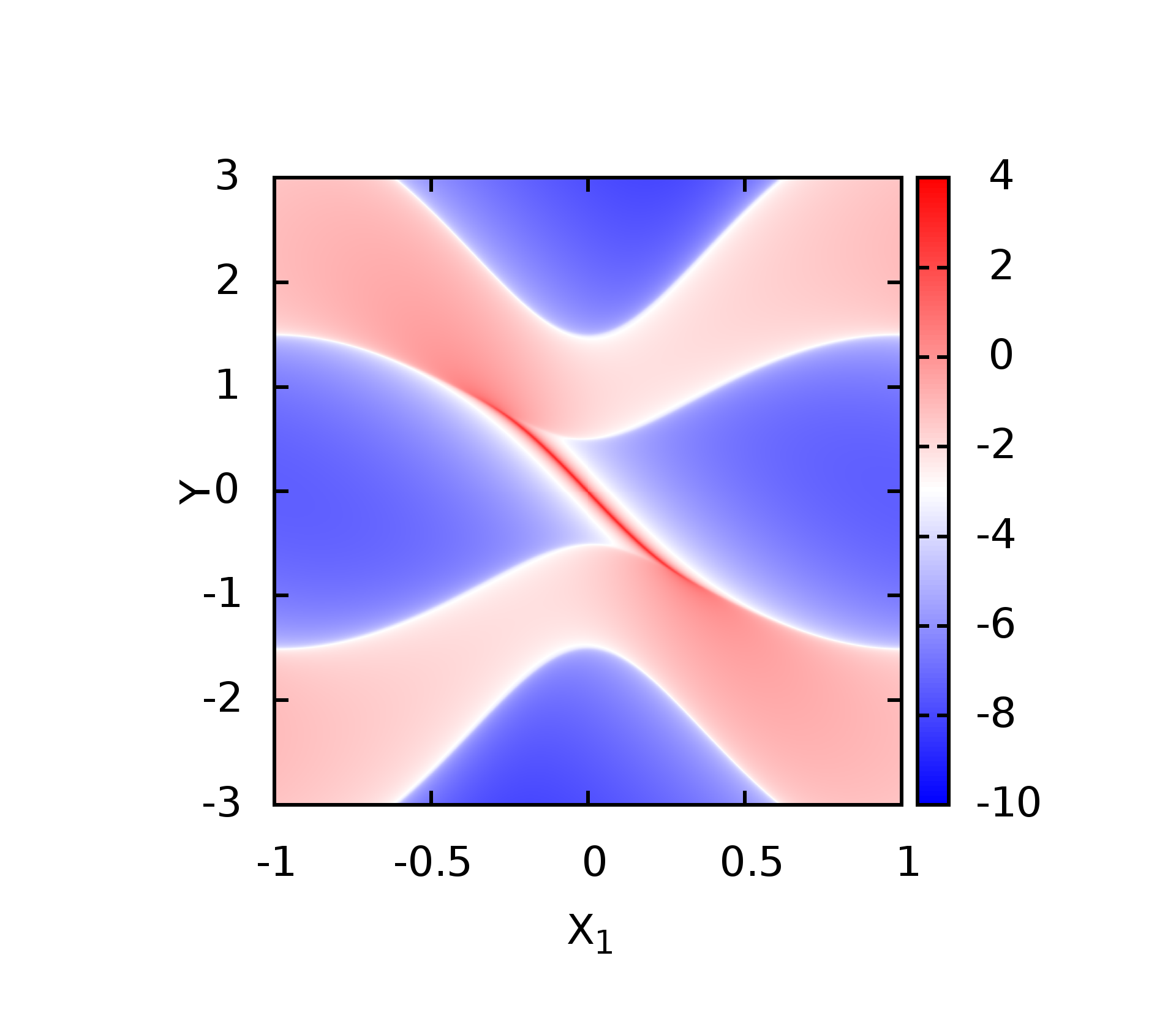
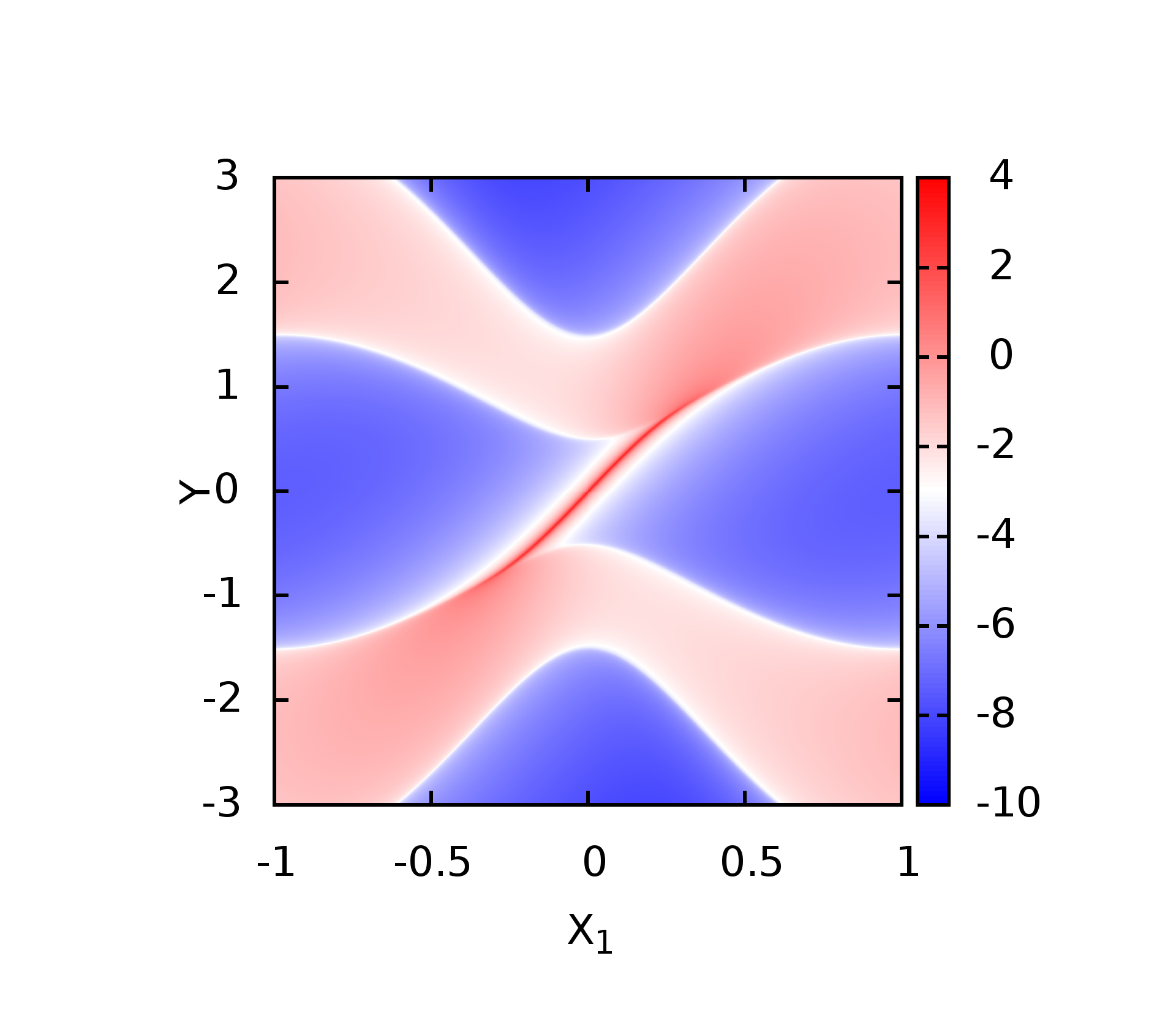
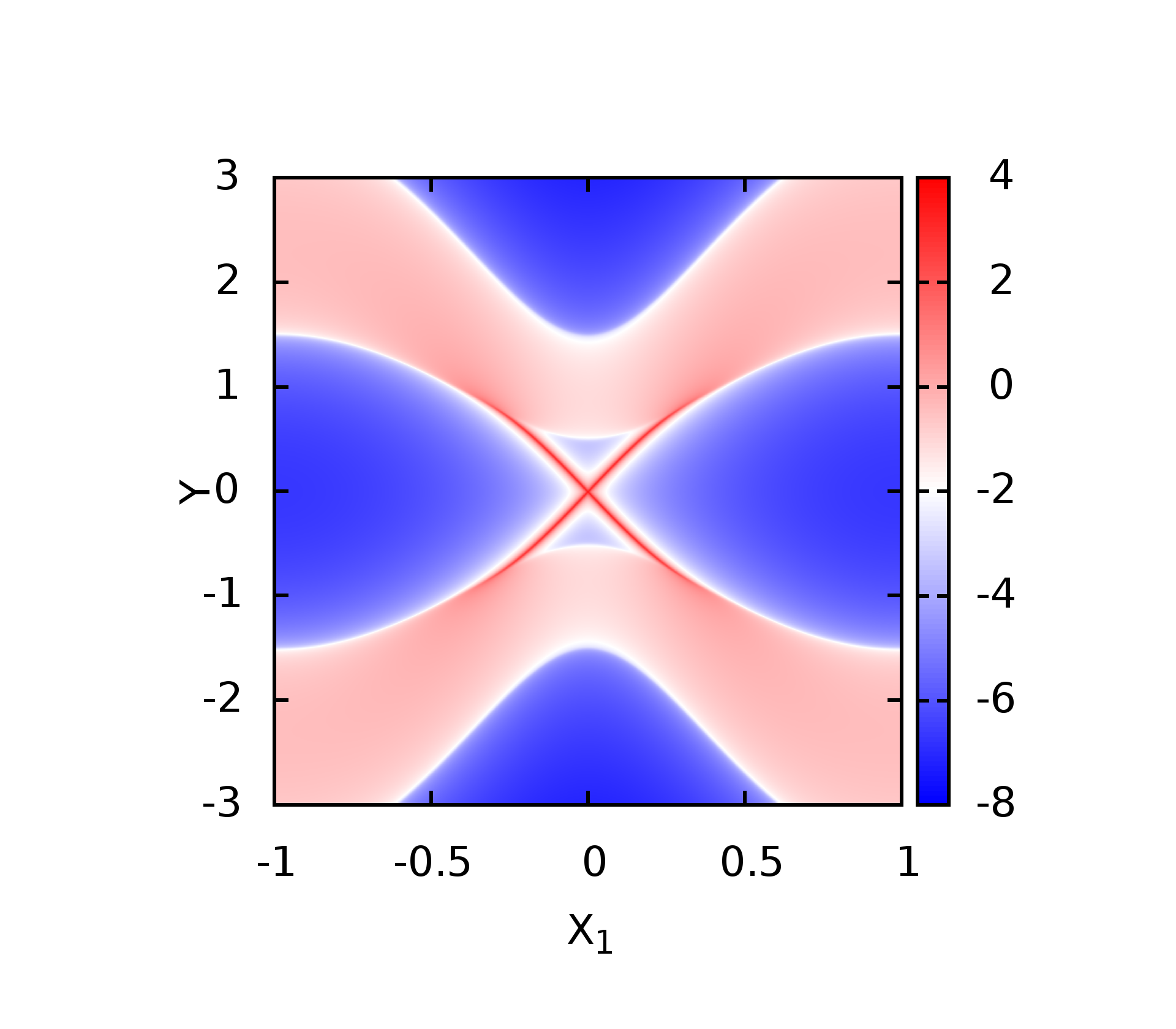
这里的第三张是将两个边界态同时计算的结果.
代码
Julia
using LinearAlgebra,DelimitedFiles,PyPlot
#---------------------------------------------------
function Pauli()
hn = 4
g1 = zeros(ComplexF64,hn,hn)
g2 = zeros(ComplexF64,hn,hn)
g3 = zeros(ComplexF64,hn,hn)
#------
g1[1,1] = 1
g1[2,2] = -1
#--------
g2[1,2] = 1
g2[2,1] = 1
#---------
g3[1,2] = -1im
g3[2,1] = 1im
return g1,g2,g3
end
# ========================================================
function matset(ky::Float64)
hn::Int64 = 2
H00 = zeros(ComplexF64,hn,hn)
H01 = zeros(ComplexF64,hn,hn)
g1 = zeros(ComplexF64,hn,hn)
g2 = zeros(ComplexF64,hn,hn)
g3 = zeros(ComplexF64,hn,hn)
#--------------------
m0::Float64 = 1.5
tx::Float64 = 1.0
ty::Float64 = 1.0
ax::Float64 = 1.0
ay::Float64 = 1.0
g1,g2,g3 = Pauli()
#--------------------
for m in 1:hn
for l in 1:hn
H00[m,l] = (m0-ty*cos(ky))*g1[m,l] + ay*sin(ky)*g3[m,l]
H01[m,l] = (-tx*g1[m,l] - 1im*ax*g2[m,l])/2
end
end
#------
return H00,H01
end
# ====================================================================================
function gf(omg::Float64,ky::Float64)
hn::Int64 = 2
iter::Int64 = 0
itermax::Int64 = 100
eta::Float64 = 0.01
omegac::ComplexF64 = 0.0
accuarrcy::Float64 = 1E-7
erracc::Float64 = 0.0
epsilon0 = zeros(ComplexF64,hn,hn)
epsilon0s_1 = zeros(ComplexF64,hn,hn)
epsilon0s_2 = zeros(ComplexF64,hn,hn)
epsiloni = zeros(ComplexF64,hn,hn)
epsilonis_1 = zeros(ComplexF64,hn,hn)
epsilonis_2 = zeros(ComplexF64,hn,hn)
alpha0 = zeros(ComplexF64,hn,hn)
alphai = zeros(ComplexF64,hn,hn)
beta0 = zeros(ComplexF64,hn,hn)
betai = zeros(ComplexF64,hn,hn)
H00 = zeros(ComplexF64,hn,hn)
H01 = zeros(ComplexF64,hn,hn)
unit = zeros(ComplexF64,hn,hn)
GLL = zeros(ComplexF64,hn,hn)
GRR = zeros(ComplexF64,hn,hn)
GBulk = zeros(ComplexF64,hn,hn)
#------------------------------------------
omegac = omg + 1im*eta
H00,H01 = matset(ky)
epsilon0s_1 = H00
epsilon0s_2 = H00
epsilon0 = H00
alpha0 = H01
beta0 = conj(transpose(H01))
#-------------------------------------
for i in 1:hn
unit[i,i] = 1
end
#--------------------------------------------
for iter in 1:itermax
epsilonis_1 = epsilon0s_1 + alpha0*inv(omegac*unit - epsilon0)*beta0
epsilonis_2 = epsilon0s_2 + beta0*inv(omegac*unit - epsilon0)*alpha0
epsiloni = epsilon0 + alpha0*inv(omegac*unit - epsilon0)*beta0 + beta0*inv(omegac*unit - epsilon0)*alpha0
alphai = alpha0*inv(omegac*unit - epsilon0)*alpha0
betai = beta0*inv(omegac*unit - epsilon0)*beta0
epsilon0s_1 = epsilonis_1
epsilon0s_2 = epsilonis_2
epsilon0 = epsiloni
alpha0 = alphai
beta0 = betai
erracc = abs(sum(alphai))
if erracc < accuarrcy
break
end
end
# GLL = inv(omegac*unit - epsilon0s)
# GBulk = inv(omegac*unit - epsilon0)
GLL = epsilon0s_1
GRR = epsilon0s_2
GBulk = epsilon0
return GLL,GRR,GBulk
end
# ==========================================================
function main()
hn::Int64 = 2
dk::Float64 = 0.01
domg::Float64 = 0.01
ky::Float64 = 0.0
omg::Float64 = 0.0
GLL = zeros(ComplexF64,hn,hn)
GRR = zeros(ComplexF64,hn,hn)
GBulk = zeros(ComplexF64,hn,hn)
f1 = open("test.dat","w")
for ky in -pi:dk:pi
for omg in -3:domg:3
GLL,GRR,GBulk = gf(omg,ky)
re1 = log(-imag(sum(GLL))/pi)
re2 = log(-imag(sum(GRR))/pi)
re3 = log(-imag(sum(GBulk))/pi)
writedlm(f1,[ky/pi omg re1 re2 re3],"\t")
end
writedlm(f1,"\n")
end
close(f1)
end
# =========================================================
# @time main()
main()
- 首先通过julia计算得到对应的数据
program main
implicit none
integer m1,m2,m3
call main1()
stop
end program
!=======================================================
subroutine main1()
! 读取不明行数的文件
implicit none
integer count,stat
real h1,h2,h3,h4,h5,h22
h1 = 0
h2 = 0
h3 = 0
h22 = 0
open(1,file = "test.dat")
open(2,file = "test-format.dat")
count = 0
do while (.true.)
count = count + 1
h22 = h1
read(1,*,iostat = STAT)h1,h2,h3,h4,h5
if(h22.ne.h1)write(2,*)"" ! 在这里加空行是为了gnuplot绘制密度图
write(2,999)h1,h2,h3,h4,h5 ! 数据格式化
if(stat .ne. 0) exit ! 当这个参数不为零的时候,证明读取到文件结尾
end do
! write(*,*)h1,h2,h3
! write(*,*)count
close(1)
close(2)
999 format(10f11.6)
return
end subroutine main1
- 接下来通过fortran来将数据进行格式化之后,准备作图
set encoding iso_8859_1
#set terminal postscript enhanced color
#set output 'arc_r.eps'
#set terminal pngcairo truecolor enhanced font ",50" size 1920, 1680
set terminal png truecolor enhanced font ",50" size 1920, 1680
set output 'Chern-3.png'
#set palette defined ( -10 "#194eff", 0 "white", 10 "red" )
set palette defined ( -10 "blue", 0 "white", 10 "red" )
#set palette rgbformulae 33,13,10
unset ztics
unset key
set pm3d
set border lw 6
set size ratio 1
set view map
set xtics
set ytics
#set xlabel "K_1 (1/{\305})"
set xlabel "X_1"
#set ylabel "K_2 (1/{\305})"
set ylabel "Y"
set ylabel offset 1, 0
set colorbox
set xrange [-1:1]
set yrange [-3:3]
set pm3d interpolate 4,4
#splot 'wavenorm.dat' u 1:2:3 w pm3d
#splot 'wavenorm.dat' u 1:2:3 w pm3d
splot 'test-format.dat' u 1:2:5 w pm3d
- 最后利用gnuplot进行图形绘制即可
Fortran
同样可以利用Fortran来进行计算
module pub
implicit none
integer N,iternum,hn
real err,eta,dk,domg
parameter( hn = 2, N = hn,iternum = 200,err = 1e-16,eta = 0.01,dk = 0.01,domg = dk)
real,parameter::pi = 3.1415926535
complex,parameter::im = (0.,1.0)
complex ones(N,N),GLL(N,N),GRR(N,N),GB(N,N)
complex H00(N,N) ! diagonal elementery
complex H01(N,N) ! off-diag elementery
complex g1(hn,hn),g2(hn,hn),g3(hn,hn)
!---------------------------------------------
real m0,mu
real tx,ty
real ax,ay
end module pub
!==================================================================
program main
use pub
!======parameter value setting =====
m0 = 1.5
tx = 1.0
ty = 1.0
ax = 1.0
ay = 1.0
call surfstat()
stop
end program main
!============================================================================================
subroutine surfstat()
! surfstat calculates surface state using green's function method---J.Phys.F.Met.Phys.15(1985)851-858
! 利用已经求得的格林函数来计算对应的态密度
use pub
implicit none
real kx,omg,re1,re2,re3
real t_start,t_end
integer i1
open(20,file="dos.dat")
call cpu_time(t_start)
!------------------------------------------
do kx = -pi,pi,dk
call matset(kx)
do omg = -3,3,domg
call itera(omg,kx)
re1 = log(abs(sum(aimag(GLL))))
re2 = log(abs(sum(aimag(GRR))))
re3 = log(abs(sum(aimag(GB))))
write(20,999)kx/pi,omg,re1,re2,re3
end do
write(20,*)" "
end do
!------------------------------------------
call cpu_time(t_end)
close(20)
write(*,*)"Timing const is: ",t_end - t_start
999 format(30f16.12)
return
end subroutine surfstat
!=================================================================
subroutine itera(omega,ky)
use pub
real omega,real_temp,ky
integer iter
complex omegac
complex g0dem(N,N), g0(N,N) ! Green's Function
complex epsiloni(N,N),epsilons(N,N),epsilons_t(N,N),alphai(N,N),betai(N,N) ! 迭代过程变量
complex GLLdem(N,N),GRRdem(N,N),GBdem(N,N),mat1(N,N),mat2(N,N)
!----------------------------
call matset(ky)
epsiloni = H00
epsilons = H00
epsilons_t = H00
alphai = H01
betai = conjg(transpose(H01))
omegac = omega + eta*im
!----------------------------------
do iter = 1, iternum
g0dem = omegac*ones - epsiloni ! Green's Function
call inv(g0dem, g0)
mat1 = matmul(alphai, g0)
mat2 = matmul(betai, g0)
g0 = matmul(mat1,betai)
epsiloni = epsiloni + g0
epsilons = epsilons + g0
g0 = matmul(mat2,alphai)
epsiloni = epsiloni + g0
epsilons_t = epsilons_t + g0
g0 = matmul(mat1, alphai)
alphai = g0
g0 = matmul(mat2, betai)
betai = g0
real_temp = sum(abs(alphai))
if (real_temp .le. err)then
exit
end if
end do ! end of iteration
! calculate surface green's function
GLLdem = omegac*ones- epsilons
call inv(GLLdem, GLL)
! GLL = epsilons
GRRdem = omegac*ones- epsilons_t
call inv(GRRdem, GRR)
! GRR = epsilons_t
GBdem = omegac*ones- epsiloni
call inv(GBdem, GB)
! GB = epsiloni
end subroutine itera
!================================================================
subroutine matset(ky)
! 构建哈密顿量
use pub
real ky
integer m,l
call Pauli()
do m = 1,hn
do l = 1,hn
H00(m,l) = (m0-ty*cos(ky))*g1(m,l) + ay*sin(ky)*g3(m,l)
H01(m,l) = (-tx*g1(m,l) - im*ax*g2(m,l))/2
end do
end do
!----------------------
! 初始化单位矩阵
do ix = 1,N
ones(ix,ix) = 1.0
end do
return
end subroutine matset
!=======================矩阵求逆====================================
subroutine inv(matin,matout)
use pub
complex,intent(in) :: matin(N,N) ! N is dimension of matrix which can be readed from pub model (use pub)
complex:: matout(size(matin,1),size(matin,2))
real:: work2(size(matin,1)) ! work2 array for LAPACK
integer::ipiv(size(matin,1)) ! pivot indices
integer info ! inv solution information
! Store matin in matout to prevent it from being overwritten by LAPACK
matout = matin
! SGETRF computes an LU factorization of a general M-by-N matrix A
! using partial pivoting with row interchanges.
call CGETRF(N,N,matout,N,ipiv,info)
if (info.ne.0) stop 'Matrix is numerically singular!'
! SGETRI computes the inverse of a matrix using the LU factorization
! computed by SGETRF.
call CGETRI(N,matout,N,ipiv,work2,N,info)
if (info.ne.0) stop 'Matrix inversion failed!'
return
end subroutine inv
!====================================================
subroutine Pauli()
use pub
!----------
g1(1,1) = 1
g1(2,2) = -1
!----------
g2(1,2) = 1
g2(2,1) = 1
!----------
g3(1,2) = -im
g3(2,1) = im
return
end subroutine Pauli
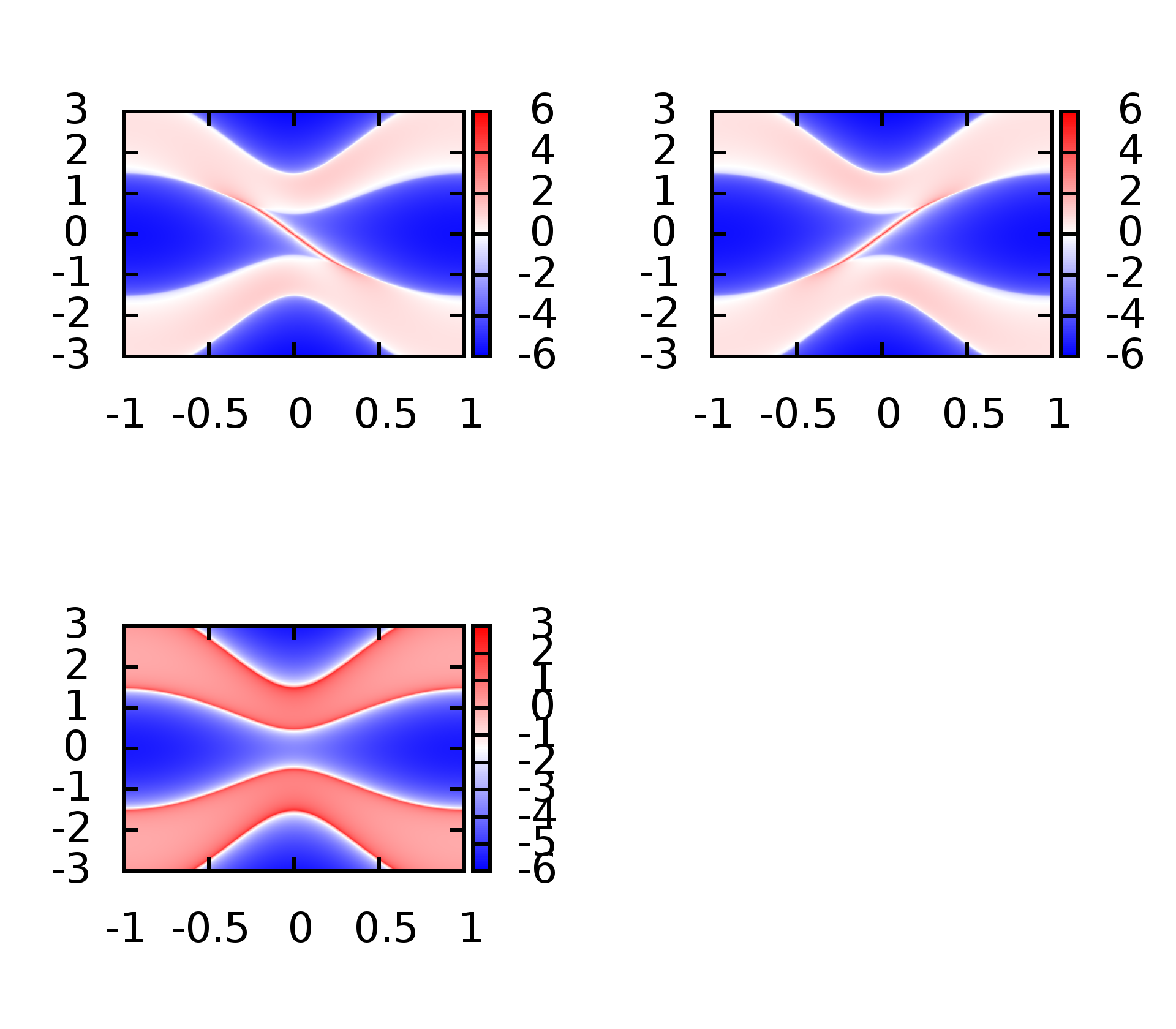
此时可以同时计算出左边界,有边界以及体态的能带.
补充
上面是将三张分开绘制的,利用的分别是数据的第三,第四,第五列,这里将三个结果绘制到统一张图上
set encoding iso_8859_1
#set terminal postscript enhanced color
#set output 'arc_r.eps'
#set terminal pngcairo truecolor enhanced font ",50" size 1920, 1680
set terminal png truecolor enhanced font ",50" size 1920, 1680
set output 'Chern.png'
#set size 2, 1
#set palette defined ( -10 "#194eff", 0 "white", 10 "red" )
set palette defined ( -10 "blue", 0 "white", 10 "red" )
#set palette rgbformulae 33,13,10
set multiplot layout 2,2
unset ztics
unset key
set pm3d
set border lw 6
#set size ratio 1
set view map
#set xtics
#set ytics
#set xlabel "K_1 (1/{\305})"
#set xlabel "X_1"
#set ylabel "K_2 (1/{\305})"
#set ylabel "Y"
#set ylabel offset 1, 0
set colorbox
set xrange [-1:1]
set yrange [-3:3]
set pm3d interpolate 4,4
#splot 'wavenorm.dat' u 1:2:3 w pm3d
#splot 'wavenorm.dat' u 1:2:3 w pm3d
splot 'test-format.dat' u 1:2:3 w pm3d
splot 'test-format.dat' u 1:2:4 w pm3d
splot 'test-format.dat' u 1:2:5 w pm3d
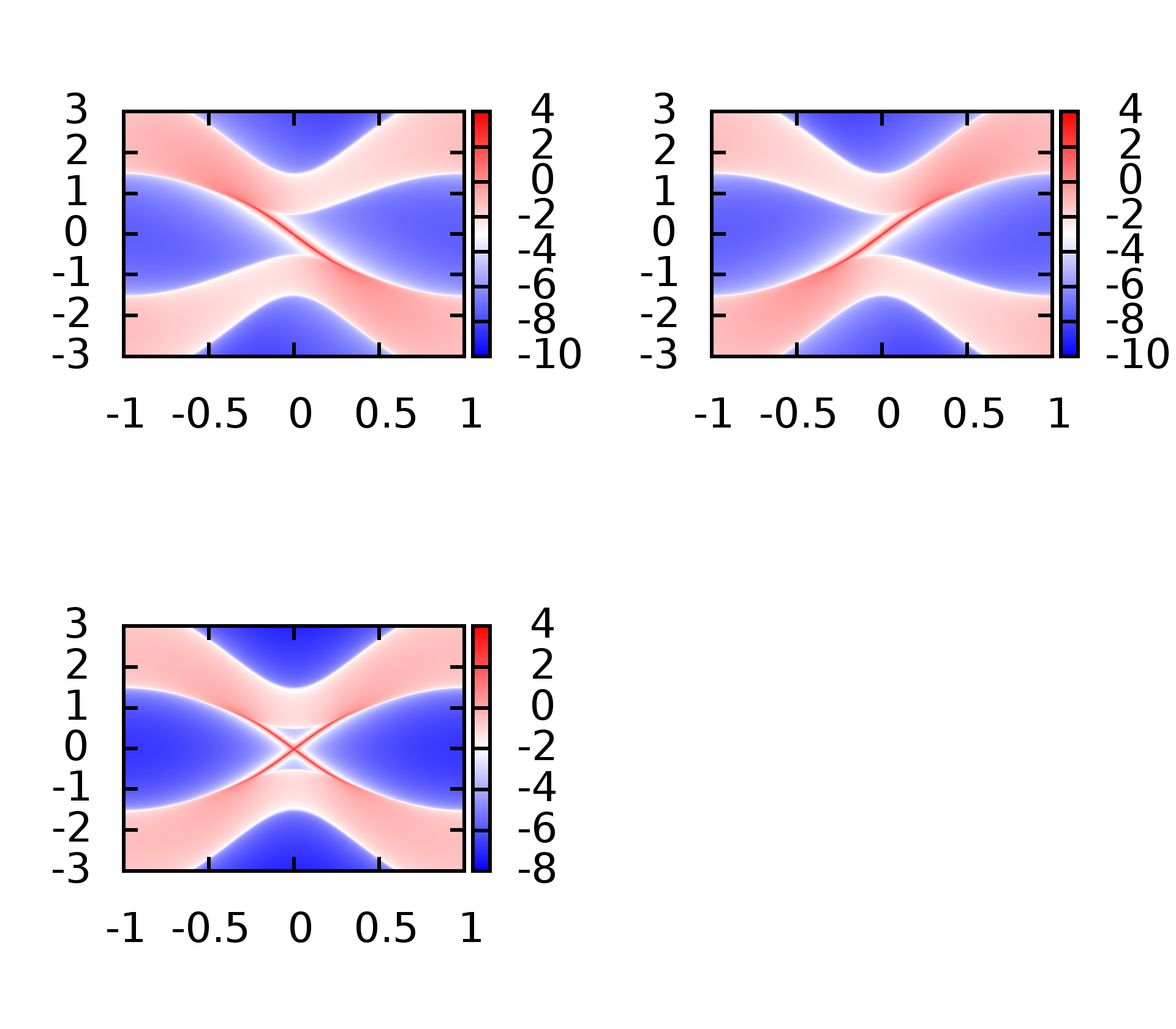
Python Version
最近搞科研,发现许多函数还是使用python比较好,借用其比较好的生态,想要实现某些功能不需要自己去写相对应的函数
import numpy as np
import matplotlib.pyplot as plt
import os
import time
import seaborn as sns
def Pauli():
s0 = np.array([[1,0],[0,1]])
sx = np.array([[0,1],[1,0]])
sy = np.array([[0,-1j],[1j,0]])
sz = np.array([[1,0],[0,-1]])
return s0,sx,sy,sz
#------------------------------------------------
def hamset(ki):
m0 = 1.5
tx = 1.0
ty = 1.0
ax = 1.0
ay = 1.0
s0,sx,sy,sz = Pauli()
H00 = np.zeros((2,2),np.complex128)
H01 = np.zeros((2,2),np.complex128)
for i0 in range(2):
for i1 in range(2):
H00[i0,i1] = (m0 - tx*np.cos(ki))*sz[i0,i1] + ax*np.sin(ki)*sx[i0,i1]
H01[i0,i1] = -ty/2.0*sz[i0,i1] + ay/(2.0*1j)*sy[i0,i1]
return H00,H01
# -----------------------------------------------------------------------
def Iteration(omega,ki):
err = 1e-16
eta = 0.01
iternum = 200
H00 = np.zeros((2,2),np.complex128)
H01 = np.zeros((2,2),np.complex128)
H00,H01 = hamset(ki)
epsiloni = H00
epsilons = H00
epsilons_t = H00
alphai = H01
betai = H01.T.conjugate() # 转置共轭
omegac = omega + eta*1j
s0,sx,sy,sz = Pauli()
for i0 in range(iternum):
g0dem = omegac*s0 - epsiloni
g0 = np.linalg.inv(g0dem)
mat1 = np.dot(alphai,g0)
mat2 = np.dot(betai,g0)
g0 = np.dot(mat1,betai)
epsiloni = epsiloni + g0
epsilons = epsilons + g0
g0 = np.dot(mat2,alphai)
epsiloni = epsiloni + g0
epsilons_t = epsilons_t + g0
g0 = np.dot(mat1, alphai)
alphai = g0
g0 = np.dot(mat2,betai)
betai = g0
real_temp = np.sum(np.concatenate(np.abs(alphai)))
if (real_temp < err):
break
GLLdem = omegac*s0 - epsilons
GLL = np.linalg.inv(GLLdem)
# GLL = epsilons
GLL = np.sum(np.concatenate(np.abs(GLL)))
GRRdem = omegac*s0 - epsilons_t
GRR = np.linalg.inv(GRRdem)
GRR = np.sum(np.concatenate(np.abs(GRR)))
# GRR = epsilons_t
GBdem = omegac*s0 - epsiloni
GB = np.linalg.inv(GBdem)
GB = np.sum(np.concatenate(np.abs(GB)))
# GB = epsiloni
return GLL,GRR,GB
#------------------------------------------------------------
def surface():
nx = 100
max_omg = 1.5
re = np.zeros((len(range(-nx,nx))**2,5))
con = 0
ix = -1
iy = -1
GLL = np.zeros((len(range(-nx,nx)),len(range(-nx,nx))))
GRR = np.zeros((len(range(-nx,nx)),len(range(-nx,nx))))
GB = np.zeros((len(range(-nx,nx)),len(range(-nx,nx))))
for i0 in range(-nx,nx):
kx = np.pi*i0/nx
for i1 in range(-nx,nx):
omg = max_omg*i1/nx
re1,re2,re3 = Iteration(omg,kx)
re[con,0] = kx
re[con,1] = omg
re[con,2] = re1
re[con,3] = re2
re[con,4] = re3
GLL[iy,ix] = np.log(re1)
GRR[iy,ix] = np.log(re2)
GB[iy,ix] = np.log(re3)
con += 1
iy += 1
ix += 1
iy = 0
# np.savetxt("GLL.dat", [kilist,re1list], fmt="%15.10f")
# np.savetxt("GRR.dat", [kilist,re1list], fmt="%15.10f")
# np.savetxt("GB.dat", [kilist,re1list], fmt="%15.10f")
np.savetxt("density.dat",re , fmt="%15.10f")
return GLL,GRR,GB
#-----------------------------------------------------------------------
def main():
os.chdir(os.getcwd())
tstart = time.time()
GLL,GRR,GB = surface()
tend = time.time()
#print(tend - tstart)
# 绘图
sns.set()
ax = sns.heatmap(GB)
plt.show()
#-----------------------------------------------------------------------
if __name__ == '__main__':
main()
这里最终计算的结果肯定是相同的,只不过绘图的时候给出的横纵坐标我没有去设置,这个具体使用的时候,到后面再去慢慢调整。
参考
公众号
相关内容均会在公众号进行同步,若对该Blog感兴趣,欢迎关注微信公众号。

|
yxli406@gmail.com |